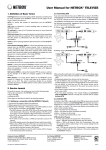Download Programming the AVR microcontroller with GCC
Transcript
352, Programming the AVR microcontroller with GCC, libc 1.0.4
Home | Electronics | Graphics, Film & Animation | E-cards | Other Linux stuff | Photos | Online-Shop
Content:
Introduction
Software installation:
What you need
Software installation:
GNU binutils
Software installation:
AVR gcc
Software installation:
The AVR C-library
Software installation:
The Programmer
A small test project
Needed Hardware
Building the
programmer hardware
Writing software
Compiling and loading
Some interesting
binutils
Ideas and suggestions
References
Programming the AVR microcontroller with GCC,
libc 1.0.4
Abstract:
The AVR 8-Bit RISC microcontroller from Atmel is a very common
microcontroller. This microcontroller is one chip with EEPROM, Ram, Analog to
Digital converter, a lot of digital input and output lines, timers, UART for RS 232
communication and many other things.
The best is however that a complete programming environment is available under
Linux: You can program this microcontroller in C using GCC.
I wrote already in March 2002 an article about the same subject. A lot of things
have changed in the avr-libc development and the AT90S4433 microcontroller
which I used in 2002 is no longer manufactured by Atmel. This is therefore an
update of the March 2002 article. I will use libc-1.0.4 and the ATmega8
microcontroller.
This article shall be only an introduction and in a later series of articles we will
again build interesting hardware but this time based on the ATmega8.
_________________ _________________ _________________
Introduction
Many people where interested in microcontroller programming after the article which I wrote in 2002. However this
first step to get the development environment up and running is the hardest. If something does not work then you
have absolutely no clue where the fault is. Programmer cable wrong?? Circuit faulty? Installation incorrect?
Parallelport disabled in bios? Kernel modules for ppdev compiled wrong? There can be a lot of reasons why things
don’t work.
To make the entrance to the exciting world of microcontrollers easier shop.tuxgraphics.org
offers now a bootable CD with a manual and the programmer hardware. All you need to do
then is boot from this CD and everything is up and running. No software installation is
1 of 8
352, Programming the AVR microcontroller with GCC, libc 1.0.4
required and nothing is modified on your local computer.
Even I use such a CD now for a while because the hardware I build often survives several generations of
kernels and software installations on my PC. If I want later on to update some microcontroller software
then I do not have to worry if the development environment on my Linux PC is still working. I just boot
from the CD and it is up and running.
Independent of this CD I will explain the installation of the GCC avr development environment in the
following paragraphs. If you have the CD from tuxgraphics then continue with chapter "A small test
project".
Software installation: What you need
To use the GNU C development environment you need the following software:
Available from:
ftp://ftp.gnu.org/gnu/binutils/
binutils-2.15.tar.bz2 or any mirror. E.g:
ftp://gatekeeper.dec.com/pub/GNU/binutils/
Available from: ftp://ftp.gnu.org/gnu/gcc/
gcc-core-3.4.2.tar.bz2 or any mirror. E.g:
ftp://gatekeeper.dec.com/pub/GNU/gcc/
avr-libc-1.0.4.tar.bz2 The AVR C-library is available from: http://savannah.nongnu.org/projects/avr-libc/
uisp-20040311.tar.bz2 The AVR programmer software is available from: http://savannah.nongnu.org/projects/uisp
We will install all the programs to /usr/local/avr. This is to keep the program separate from your normal Linux C
compiler. Create this directory with the command:
mkdir /usr/local/avr
You can add it already now to your PATH:
mkdir /usr/local/avr/bin
export PATH=/usr/local/avr/bin:${PATH}
Software installation: GNU binutils
The binutils package provides all the low-level utilities needed for building object files. It includes an AVR
assembler (avr-as), linker (avr-ld), library handling tools (avr-ranlib, avr-ar), programs to generate object files
loadable to the microcontroller’s EEPROM (avr-objcopy), disassembler (avr-objdump) and utilities such as avr-strip
and avr-size.
Run the following commands to build and install the binutils :
tar jxvf binutils-2.15.tar.bz2
cd binutils-2.15/
mkdir obj-avr
cd obj-avr
../configure --target=avr --prefix=/usr/local/avr --disable-nls
make
# as root:
make install
Add the line /usr/local/avr/lib to the file /etc/ld.so.conf and run the command /sbin/ldconfig to rebuild the linker
cache.
2 of 8
352, Programming the AVR microcontroller with GCC, libc 1.0.4
Software installation: AVR gcc
avr-gcc will be our C compiler.
Run the following command to build and install it:
tar jxvf gcc-core-3.4.2.tar.bz2
cd gcc-3.4.2
mkdir obj-avr
cd obj-avr
../configure --target=avr --prefix=/usr/local/avr --disable-nls --enable-languag
make
# as root:
make install
Software installation: The AVR C-library
The C-library is quite stable now compared to the one I presented in March 2002.
Run the following command to build and install it:
tar jxvf avr-libc-1.0.4.tar.bz2
cd avr-libc-1.0.4
PREFIX=/usr/local/avr
export PREFIX
sh -x ./doconf
./domake
cd build
#as root:
make install
Software installation: The Programmer
The programmer software loads the specially prepared object code into the EEPROM of our microcontroller.
The uisp programmer for Linux is a very good programmer. It can be used directly from within a Makefile. You just
add a "make load" rule and you can compile and load the software in one go.
uisp is installed as follows:
tar jxvf uisp-20040311.tar.bz2.tar
cd uisp-20040311
./configure --prefix=/usr/local/avr
make
# as root:
make install
A small test project
3 of 8
352, Programming the AVR microcontroller with GCC, libc 1.0.4
We will start with a small test circuit which you can expand later on.
This circuit can also be used as a simple test environment for more complex hardware. You can easily test load
software and attach sensors or measurement equipment.
Our test program as presented here will just cause a LED to blink.
Needed Hardware
You need the parts listed in the table below. Although it is a very
common microcontroller it might not be available in every local radio
shop but bigger distributors for electronic components like (
www.conrad.de (germany), www.selectronic.fr (france), digikey.com
(US, CA), etc... have it in store).
The best place to get the microcontroller and the other parts is
however: shop.tuxgraphics.org ;-).
1 x ATmega8 DIP version, Atmel 8 bit Avr risc processor.
1 x 28 pin 7.5mm IC socket
The 28 pin socket is a bit more difficult to get. Usually the 28 sockets are 14mm
wide but we need a 7.5mm socket.
1 x 10K resistor (color code: brown,black,orange)
1 x 1K resistor (color code: brown,black,red)
1 x 10uF electrolytic capacitor
Some wires
1 x LED
4 of 8
352, Programming the AVR microcontroller with GCC, libc 1.0.4
matrix board
The following is needed for the programmer (not needed if you get the "Linux AVR
programming kit" from tuxgraphics):
1 x DB25 connector to plug into the parallel port.
Any kind of 5 pin connector/socket for the programmer. I recommend to use
precision strip connectors (similar to IC sockets) and break 5 pins off.
1 x 220 Ohm resistor (color code: red,red,brown)
2 x 470 Ohm resistor (color code: yellow,purple,brown)
In addition to the above parts you need a 5V electronically stabilized DC power supply or you can use a 4.5V battery
as power supply.
You have probably noticed that we do not need a crystal. This is because the ATmega8 has now a build-in oscilator.
This oscilator can be used when accurate timing is not an issue. However if you want to build precise measurement
equipment or you want to use the UART/RS232 interface then you will need a crystal. Which type of oscilator is
used can be defined via fuse bits which you can modify with the programmer. By default (factory setting) the internal
1Mhz oscilator is active.
Building the programmer hardware
The AVR microcontrollers allows for in circuit programming (ISP).
That is: you do not need to remove the microcontroller form the board
to program it. You will see that you can get different programmer
hardware from 50-150 Euro. However with Linux running it is also
possible to build a very simple programmer that does the job. You
need a free parallel port on your computer and the following cable.
Note that this is an improved programmer compared to the one
presented in the March 2002 article. We build the protection resistors
into the programmer. This will then save some space and parts on the
circuit board. The wiring for the programmer cable has to be as
follows:
pin on pcb pin on AVR protection resistor Pin on parallel port
5
Reset (1)
-Init (16)
4
MOSI (17) 470 Ohm
D0 (2)
3
MISO (18) 220 Ohm
Busy (11)
2
SCK (19)
470 Ohm
Strobe (1)
1
GND
-GND (18)
The cable should not be longer than 70cm.
The protection resistors can be build into the connector as show on the picture on the right.
Writing software
The Atmeag 8 can be programmed in plain C with the help of gcc. To know some AVR assembler can be useful but
it is not needed.
The AVR libc comes with an avr-libc-user-manual-1.0.4.pdf (1139921 bytes) which documents all functions
available in C. From Atmel’s website, (www.atmel.com, go to: avr products -> 8 bit risc-> Datasheets), you can
download the complete data sheet. It describes all the registers and how to use the CPU.
One thing to keep in mind when using a microcontroller is that it has only a few bytes of Ram. That means you must
not declare large data structures or strings. Your program should not use deeply nested function calls or recursion.
Much better than all theory is a real example. We will write a program that causes our LED to blink in 0.5 seconds
intervals. Not very useful but very good to get started.
The avr-libc has changed a lot. Previously you did set a bit on a port with sbi and you cleared it with cbi. Now those
functions are deprecated. First I present the "good old way":
5 of 8
352, Programming the AVR microcontroller with GCC, libc 1.0.4
/* defines for future compatibility */
#ifndef cbi
#define cbi(sfr, bit) (_SFR_BYTE(sfr) &= ~_BV(bit))
#endif
#ifndef sbi
#define sbi(sfr, bit) (_SFR_BYTE(sfr) |= _BV(bit))
#endif
void main(void)
{
/* INITIALIZE */
/* enable PC5 as output */
sbi(DDRC,PC5);
/* BLINK, BLINK ... */
while (1) {
/* led on, pin=0 */
cbi(PORTC,PC5);
delay_ms(500);
/* set output to 5V, LED off */
sbi(PORTC,PC5);
delay_ms(500);
}
}
The following example does exactly the same but uses the new syntax:
void main(void)
{
/* INITIALIZE */
/* enable PC5 as output */
DDRC|= _BV(PC5);
/* BLINK, BLINK ... */
/* PC5 is 5 (see file include/avr/iom8.h) and _BV(PC5) is 00100000 */
while (1) {
/* led on, pin=0 */
PORTC&= ~_BV(PC5);
delay_ms(500);
/* set output to 5V, LED off */
PORTC|= _BV(PC5);
delay_ms(500);
}
}
The above code snipet shows how simple it is to write a program. You see only the main program, the delay_ms
function is included in the full listing (avrm8ledtest.c). To use pin PC5 as output you need to set the PC5 bit in the
data direction register for port C (DDRC). After that you can set PC5 to 0V with the function cbi(PORTC,PC5) (clear
bit PC5) or to 5V with sbi(PORTC,PC5) (set bit PC5). The value of "PC5" is defined in iom8.h which is included via
io.h. You don’t have to worry about it. If you have already written programs for multi user / multi tasking systems
such as Linux you know that one must never program a non blocking endless loop. This would be a waste of CPU
time and slow the system very much down. In the case of the AVR this is different. We don’t have several tasks and
there is no other program running. There is not even an operating system. It is therefore quite normal to busy loop
forever.
Compiling and loading
Before you start make sure that you have /usr/local/avr/bin in the PATH. If needed edit your .bash_profile or .tcshrc
and add:
6 of 8
352, Programming the AVR microcontroller with GCC, libc 1.0.4
export PATH=/usr/local/avr/bin:${PATH} (for bash)
setenv PATH /usr/local/atmel/bin:${PATH} (for tcsh)
We use the parallel port and uisp to program the AVR. Uisp uses the ppdev interface of the kernel. Therefore you
need to have the following kernel modules loaded:
# /sbin/lsmod
parport_pc
ppdev
parport
Check with the command /sbin/lsmod that they are loaded otherwise load them (as root) with:
modprobe parport
modprobe parport_pc
modprobe ppdev
It is a good idea to execute these commands automatically during startup. You can add them to a rc script (e.g for
Redhat /etc/rc.d/rc.local).
To use the ppdev interface as normal user root needs to give you write access by once running the command
chmod 666 /dev/parport0
Make as well sure that no printer daemon is running on the parallel port. If you have one running then stop it before
you connect the programmer cable. Now everything is ready to compile and program our microcontroller.
The package for our test program (avrm8ledtest-0.1.tar.gz) includes a make file. All you need to do is type:
make
make load
This will compile and load the software. I will not go into the details of all the commands. You can see them in the
Makefile and they are always the same. I can my self not remember all of them. I just know that I need to use "make
load". If you want to write a different program then just replace all occurrences of avrm8ledtest in the Makefile with
the name of your program.
Some interesting binutils
More interesting than the actual compilation process are some of the binutils.
Those utilities have however not really changed since March 2002. Take a look at the "Some interesting binutils"
chapter in article231, March 2002.
Ideas and suggestions
The ATmega8 is compatible to the AT90S4433 for most uses. You need to program the fuse bits to use the external
oscilator and the previously presented hardware might work with possibly minor changes. Unfortunatley I have not
had time yet to re-test all circuits for the ATmega8. If you want to be on the save side then use the AT90S4433 for
the old articles. If you don’t mind to troubleshoot and solve problems then try the ATmega8 with the old
articles/circuits.
Here is a list of those previous hardware articles:
A LCD control panel for your Linux server
A microcontroller based DC power supply
Frequency counter 1Hz-100Mhz with LCD display and RS232 interface
Linux USB LCD display with watchdog and buttons
Building an autonomous light finder robot
Note: the programmer presented here includes already the protection resistors which were build into the circuit board
7 of 8
352, Programming the AVR microcontroller with GCC, libc 1.0.4
in the older hardware articles. To use the new programmer with the old boards you will just need to replace the
protection resistors on the board by wires.
Atmel provides an application note "AVR081: Replacing AT90S4433 by ATmega8" which lists all the
incompatibilities: at90s4433_to_atmega8.pdf (101343 bytes)
References
Pascal Stang’s AVRlib: http://www.procyonengineering.com/avr/avrlib/index.html or
http://hubbard.engr.scu.edu/embedded/avr/avrlib/
the tavrasm assembler for Linux: www.tavrasm.org
All software and documents mentioned in this article
The atmel website: www.atmel.com
Electronic pages from the tuxgraphics shop: shop.tuxgraphics.org
(Here you can get the Linux AVR programming CD, kits and microcontrollers)
<--, tuxgraphics Home
Go to the index of this section
© Guido Socher, tuxgraphics.org
2005-02-26, generated by tuxgrparser version 2.52
8 of 8
















